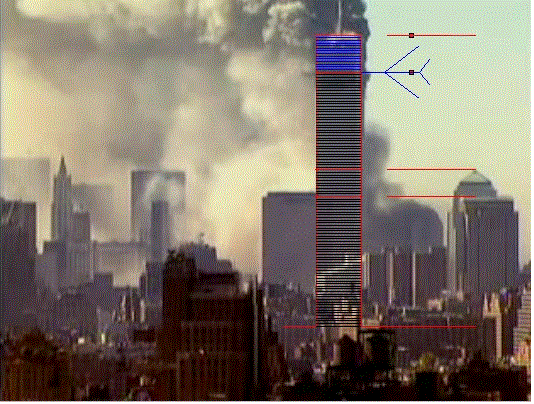New Mexicans for Science and Reason present
NMSR 9-11 'Truth' Resources
The Towers' Collapse: Fast, But Not Freefall
By Dave Thomas

New Mexicans for Science and Reason present
NMSR 9-11 'Truth' Resources
The Towers' Collapse: Fast, But Not Freefall
By Dave Thomas

A companion article describes why the collision of the growing mass of each of the Twin Towers exceeded safety margins by thirty times or more, breaking each floor in turn. How fast did the total collapses actually occur? 9/11 Truth proponents often say the towers collapsed at "near" freefall or at "virtually" free fall.
This section uses a back-of-the-envelope calculation to estimate the total durations of the collapses, as well as falling velocities, accelerations, and positions during the collapses. This explanation is offered with the caveat of Albert Einstein, who said words to the effect of "Everything should be made as simple as possible, but not simpler." That said, the results of the simple model described herein compare quite well to those of much more rigorous and accurate approaches.
If the towers did collapse at freefall acceleration, that would indeed indicate there was no resistance to their falling, and that perhaps the building underneath had been removed by controlled demolition, creating an empty space for the freefall to proceed. This page will show that the collapses were not at freefall, and that there was resistance at every step in the process.
Here are the main points in the calculation.
| Some preliminaries: for an object falling from rest at gravity acceleration g, the drop height h equals (1/2) g t2. Solving for time of the drop: |  |
| If the initial velocity is non-zero - if the object is already falling at speed v0 - then the time to fall a distance h is shorter. Using the quadratic formula to solve for the drop time yields this finding: |  |
| Here is the drop time for the upper section of the North Tower right after the initial failure of the perimeter walls. The upper section takes 0.881 seconds to get up to 8.63 m/sec, or about 19 miles per hour. |  |
| When the 58-million-kg mass of the upper section impacts the 95th floor, the dynamic force is about 30 times the static load, far in excess of design limits, causing the columns and supports to fail. The resistance of these horizontal floor supports slows down the falling mass, from 19 down to 18 miles per hour, in accordance with conservation of momentum. In this type of collision (inelastic), the two colliding objects stick together. |  |
| Here is the drop time for the upper section of the North Tower right after the initial floor impact described above. The upper section takes 0.383 seconds to get up to 11.8 m/sec, or about 26.4 miles per hour |  |
| When the now-62-million-kg mass of the upper section impacts the 95th floor, the dynamic force is still about 30 times the static load, again causing the columns and supports to fail. The resistance of these horizontal floor supports again slows down the falling mass, from about 26 down to about 25 miles per hour, again conserving momentum. |  |
| Here is a summary of the first few steps of the collapse. As the growing mass falls through each additional floor, it gains speed. This new speed is reduced slightly by the collision with the next floor, but still exceeds the speed at the start of the cycle. So, each floor is crushed in a shorter time than the one above it. Once the Juggernaut starts, it gets bigger and faster with every floor that is collapsed. |  |
| The overall results compare very well with observed times, and also with more detailed calculations. The range of collapse times is for crush-down/crush-down + crush-up, per Bazant et. al. |  |
This calculation shows that the towers did NOT collapse at "free-fall" accelerations. There was resistance at every step. However, the collapse process was such that each floor was crushed faster than the preceding one, making the entire collapse occur in under 15 seconds or so.
Animated Movie: Model Overlaid with WTC 1 Collapse
Results of the physics model of the tower collapse presented above, compared to actual. The two small red squares falling on the right represent objects dropped from the top (110th) and impact-level (96th) stories, and these are in true freefall. The towers are clearly falling at less than freefall speeds in this physics analysis. The horizontal red lines (top of WTC1, top of WFC3, top of WTC7, and ground level) were used to calibrate the scale of the plot. Note how the smoke plume at the point of impact tracks the calculated position of the upper section (blue lines).

| Knowing the Dynamic Force itself, and the change in velocity, allows the calculation of the time interval for the collision itself. Here, the collision time for the first impact is about two milliseconds, or about 1/500th of a second. Later collisions were even shorter, ending at around just three-quarters of a millisecond for the lowermost floors. |  |
The next article in this series combines this momentum calculation and and the Dynamic Force article to show that 9/11 Truth Physics is based on a colossal physics mistake, and also that David Chandler's measurements actually support the models presented here.

NMSR 9-11 'Truth' Resources
How Does a Building Crush Itself?
The Towers' Collapse: Fast, But Not Freefall
Chandler's Data Support a Gravitational Collapse!
World Trade Center 7 : What Really Happened
How Can Gravity cause Multi-ton steel sections to be ejected laterally?
Is Thermite the Answer? What was the Question?
The Gage Page - "Blueprint of Destruction" Refutations
Main 9/11 Page
